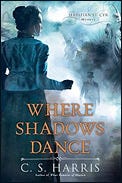Sixth in the Sebastian St. Cyr mystery series set in Regency Britain, Where Shadows Dance finds Sebastian, Viscount Devlin, upset by a recent revelation about his parentage. In the first mystery of the series, What Angels Fear, Sebastian was himself accused of murder. His skill at ferreting out the actual culprit has led to a series of unofficial investigations within the space of less than two years. Besides his keen intelligence, Sebastian's advantages as a sleuth include exceptional hearing and "strange yellow eyes with an unnatural ability to see clearly at great distances or at night, when reality was reduced for most men to vague shadows of gray."
One of Sebastian's friends, a teaching surgeon who pays "resurrectionists" to dig up bodies for him to study, is in a bind. Dissecting the corpse of an otherwise healthy young man supposed to have died of a heart defect, he discovers a more sinister cause of death which he feels duty-bound to report. Body-snatching is illegal, so instead of informing the authorities, he asks Sebastian to investigate. Unfortunately, Sebastian's inquiries keep bumping up against government secrets.
It is the summer of 1912. Napoleon is embarking on his Russian campaign, and Russia is pressuring Britain to send troops to its aid. Already fighting Napoleon in Spain and involved in an intricate series of alliances and "paper wars," not to mention the prospect of active hostilities breaking out in America, the British government has its hands full. As it tries to keep players on all sides happy, secrecy is crucial.
Meanwhile, a romantic entanglement formed during Sebastian's previous investigation both complicates and aids his quest. As dangers mount in the mystery's final chapters, Miss Hero Jarvis, the independent and strong-willed daughter of Sebastian's enemy, steals the show.
The complicated historical background of Where Shadows Dance is well researched, if sometimes hard to follow. Readers may have to suspend disbelief to accept the larger-than-life main characters; their attitudes are unorthodox for the Regency period, but thrillingly so. (2011; 342 pages, including an Author's Note separating history from fiction)





Love this series!